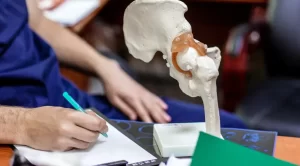Dr. Mast has operated on many athletes, dancers and yogis -who regularly require a large range of motion – without using dual mobility implants. In this video, he discusses why he doesn’t generally use them.
Patients with osteoarthritis often experience limited range of motion – from difficulties tying their shoes, to limitations when engaging in activities such as yoga or dance. In some patient circles, there’s a mistaken perception that dual mobility implants will provide a better range of motion after surgery to allow them to pursue these activities again.
These implants essentially have two bearings – a smaller one inside a larger one. This makes them very hard to dislocate as they offer a greater biomechanical range of motion before instability. This essentially means that the hip joint can travel through a larger arc before it dislocates.
However, this doesn’t always correlate to the clinical range of motion, which is actually what the patient is more interested in. In reality, it isn’t the implant that restores range of motion – rather it is replacing the dysfunctional hip that improves the range of motion as the joint is able to move freely again.








